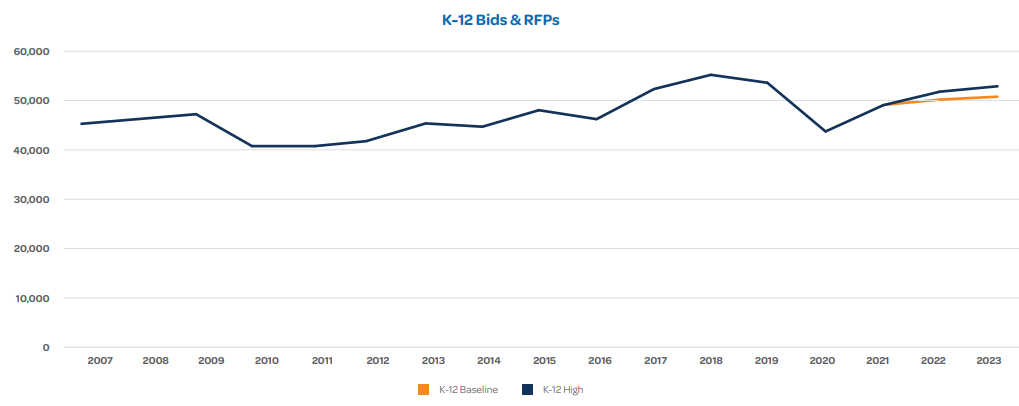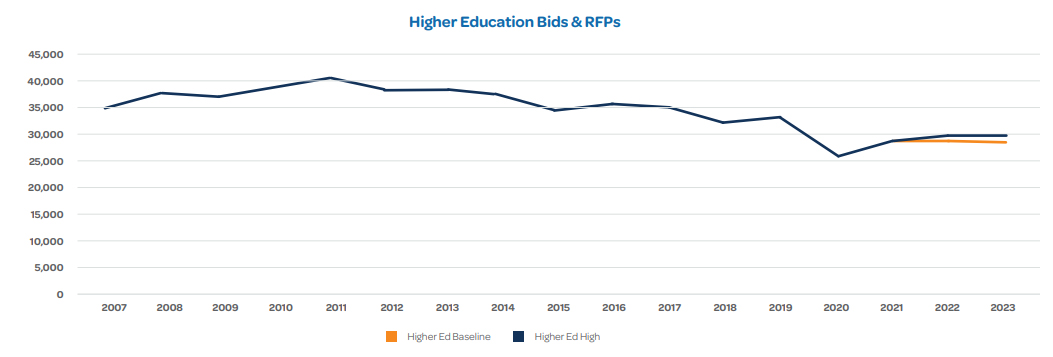Trends and Challenges in K-12 and Higher Education Government Contracting

Within the $1.5T state, local and education (SLED) government contracting market, the K-12 and higher education segments represent two large and important areas for government suppliers to consider. While on the surface the two markets are similar, each have unique drivers and requirements differentiating the two, and both markets need to be approached with a unique, strategic plan. All major industries sell into both K-12 and higher education, but there are some categories particularly strong in both and some that are uniquely strong in one or the other.
Below, the SLED research team behind Deltek’s GovWin IQ platform of government market intelligence have offered a summary of the trends relevant to each market, plus a specific focus on spending in the infrastructure and technology spaces for both market segments.
Trends in the K-12 Education Government Contracting Market
Due to unprecedented federal funding from multiple rounds of stimulus, the K-12 education market has been recovering well from the 2020 pandemic and season of remote learning. In some areas such as curriculum, textbooks and educational products, 2021 as a year already surpassed 2019 levels. However, along with the re-opening of schools, the market continues to grapple with the effects of COVID-19 on students and faculty. Overall, we project slightly more K-12 bids and RFPs in 2023, which you can see in the graph below continues a slight upward trend.

U.S. school districts are leveraging federal funding to address these issues. As mentioned in our 10 Hotspots in State & Local Government Contracting for 2022 report, procurement trends for the K-12 market include closing learning gaps, providing mental health services, and addressing needs for re-hiring and staffing. In addition, there has been greater allotment of school budgets towards professional services such as tutoring, afterschool programs, social and emotional learning programs and curriculum consulting to combat the effects of school disruptions.
Finances, Budgets and Fiscal Trends at the K-12 Level
GovWin’s Vertical Profiles product provides current year estimates of total expenditures for major types and functions of government, among other metrics. This includes $821.2 billion in FY 2022 for K-12 education. K-12 benefits from the stability of per-pupil consistent tax funding backed up by legislative requirements to meet these needs. In hard times, K-12 generally receives more protection than other functions of government and in good times, districts can afford additional “wants” alongside “needs.”
K-12 Infrastructure
Demand for infrastructure-related K-12 contracting has remained strong, driven by population growth in major metro suburbs and the remodeling and repair of older buildings. The Census of Construction Put in Place shows strong annual growth in spending within the K-12 market since 2016. Spending did peak in 2020 and decline slightly for 2021 following adjustments in projects and schedules due to the pandemic. However, even with this recent softening, the overall market rose an average of 6.3% per year from 2016 to 2021 (from $42.3 billion to $57.4 billion). While there are far fewer high schools relative to other types, the high school segment was the largest in total investment for 2021, at $29.0 billion, followed by elementary ($17.1B) and then middle/junior high ($10.1B).
K-12 Technology
“EdTech” encompasses a wide range of IT/telecom purchases and solutions from supplying laptops for students to teaching aids to database solutions. Many districts have abandoned the historical model of making a few very large investments in broad tech platforms, preferring to buy smaller-scale or more tightly defined and affordable solutions (solving problems faster and with less expenditure).
Subscription-based learning platforms implemented by school districts during the height of the pandemic have proven to be sticky. The flexibility and efficiency of these online platforms have earned themselves a permanent spot in the education market for the foreseeable future. This includes the number of vendors emerging with more cost-effective approaches and subscription-based software, together with procurement activity starting to reflect a more diverse group of vendors.
The K-12 market has not been immune to cyber-attacks that have swept the private and public sectors. As school districts now rely heavily on technology and cloud services for day-to-day functioning, a large gap in cybersecurity has left districts vulnerable. Help from qualified vendors will be needed to prevent data breaches, attacks and ransomware.
Trends in the Higher Education Government Contracting Market
The higher education market is faced with several challenges including declining student enrollment, aging infrastructure, reduced state funding and an ever-increasing demand for technology. The COVID-19 pandemic coupled with the influx of recent federal funding, has altered infrastructure funding and shifted the paradigm of higher education to more of a hybrid scenario. There are now fully in-person and fully remote classes but also options for some students within an in-person class to still learn remotely. Many universities are upgrading outdated infrastructure, including implementing efficient HVAC and air filtration systems to minimize the spread of COVID-19 and ensure student safety. As the country struggles with a mental health crisis, universities are prioritizing students’ wellbeing by investing in surveys, counselors, and mental health programs.
As a result, we project higher education bids and RFPs to remain relatively flat in 2023, as shown in the chart below.

Finances, Budgets and Fiscal Trends Within Higher Education
Affordability remains a key issue. Higher education institutions are discounting tuition, assisting students with loan payments, and providing more grants to students. According to GovWin’s Vertical Profiles data, total expenditures by all public and private higher education institutions in FY 2022 was estimated at $664.5 billion. Based on the National Center for Education Statistics, 63.4% of these expenditures are made by public institutions. Among these institutions, “instruction” or faculty salaries comprises the single largest category. Funding for the basic operation of these schools comes mainly from student tuition while infrastructure and capital improvements tend to come from tax-funded allocations at the state level.
Higher Education Infrastructure
The Census of Construction Put in Place shows demand for infrastructure-related contracting saw slight growth from 2013 to 2019 ($22B to $26B) but overall the trend has been downward. Over the past five years, from 2016 to 2021 there was an average annual rate of change of -4.1% in spending on these projects (from $25.0B to $20.3B in total). Administration, dormitory and parking facilities had the largest declines. The largest categories for 2021 include instructional facilities ($12.6B), dormitory ($2.5B) and sports/recreation ($2.2B).
Higher education infrastructure and other physical improvements has faced funding limitations as well as historical deferred maintenance. State government allocations are not guaranteed as officials will bring up their needs and try to compete for limited state dollars. Declines in enrollment as well as greater budgeting uncertainty have made their case even more challenging. However, stimulus funds from the American Rescue Plan Act (ARPA) as well as 5-10 year infrastructure act funding can potentially improve and reverse this trend.
Higher Education Technology
Since the onset of the pandemic, EdTech has rapidly grown to enhance the effectiveness of online learning. Online learning platforms and learning management systems have become essential to student learning as colleges have coped with the effects of the pandemic on students. Preferences for remote learning have remained even as campuses re-opened. The landscape of the vendor community has extended to encompass a multitude of start-up technology companies and Software as a Service (SaaS) companies, often providing education services in the form of subscriptions.
Artificial Intelligence (AI) has been deployed by higher education institutions to support various functions of online learning, including algorithms to proctor online assessments, chat bots for student and faculty assistance, and tutoring services. Additionally, Virtual Reality (VR) and Augmented Reality (AR) are tools that many universities are embracing to encourage hands-on and immersive student learning. These can be seen as becoming mainstream and more common within EdTech as the federal government emphasizes STEM programs.
The analysis shared here relies on data from Deltek’s GovWin IQ government market intelligence database of information on current, future and historical transactions in the government market, and what we have shared here only scratches the surface. Curious to learn more? Request your free trial of GovWin IQ today.

Deltek Project Nation Newsletter
Subscribe to receive the latest news and best practices across a range of relevant topics and industries.

 Log In
Log In










